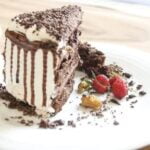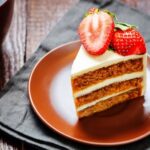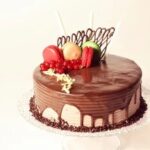Are you looking to learn how to decorate a cake with frosting? Frosting is the perfect way to take a simple cake and turn it into a show-stopping masterpiece. Whether you’re a beginner or an experienced baker, mastering the art of cake decorating with frosting can take your baking skills to the next level.
From buttercream to royal icing, there are numerous types of frostings to choose from, each offering its own unique texture and flavor. In this article, we will explore the different types of frosting, essential tools for decorating, step-by-step guides, decorating techniques, troubleshooting common mishaps, and tips for creating intricate designs.
The first step in mastering the art of cake decorating with frosting is understanding why frosting plays such a crucial role in making a cake truly fabulous. Frosting not only adds sweetness and flavor but also provides an opportunity for creativity and personalization. By learning various techniques for applying and decorating with frosting, you can transform a basic cake into a stunning centerpiece for any celebration.
In the following sections, we will explore the different types of frostings available – from classic buttercream to elegant royal icing and creamy cream cheese frosting. We will also discuss the essential tools needed for cake decorating with frosting, such as piping bags, tips, spatulas, and more.
Additionally, we will provide a detailed step-by-step guide for frosting a cake, as well as tips for creating intricate designs and troubleshooting common frosting mishaps. So let’s dive in and discover the wonderful world of cake decorating with frosting.
Types of Frosting
When it comes to decorating a cake with frosting, the type of frosting you choose can make a big difference in the taste and appearance of your confection. There are several different types of frosting to consider, each with its own unique flavor and texture. Here are some popular options to explore:
- Buttercream: This classic frosting is made with butter, powdered sugar, and flavorings. It has a rich and creamy texture that is perfect for piping decorations and creating smooth finishes.
- Royal Icing: Made from egg whites, powdered sugar, and lemon juice or cream of tartar, royal icing dries hard and is often used for intricate designs like piping lacework or creating delicate flowers.
- Cream Cheese Frosting: Tangy and creamy, this frosting is made with cream cheese, butter, powdered sugar, and vanilla. It’s a popular choice for carrot cakes and red velvet cakes.
In addition to these classic options, there are also specialty frostings to consider such as Swiss meringue buttercream, fondant, ganache, and whipped cream. Each type of frosting has its own set of pros and cons when it comes to taste, texture, and ease of use.
As you plan your cake decoration project, consider the flavor profile of your cake as well as the desired visual effect. Some frostings are better suited for smooth finishes while others are ideal for creating elaborate designs. Be sure to select a frosting that complements the overall theme of your cake.
Essential Tools for Decorating With Frosting
When it comes to decorating a cake with frosting, having the right tools is essential for achieving professional-looking results. Here are some essential tools for decorating with frosting:
- Piping bags: These disposable or reusable bags are used to pipe frosting onto cakes in various designs, such as swirls, rosettes, and borders.
- Tips: Piping tips come in different shapes and sizes, allowing decorators to create a wide range of designs. From star tips to round tips, there are endless possibilities for creating beautiful patterns and textures with frosting.
- Spatulas: Offset spatulas and straight spatulas are essential for spreading frosting evenly over the surface of a cake. They can also be used to create smooth finishes and sharp edges on cakes.
- Turntable: A revolving cake turntable allows decorators to easily spin the cake as they apply frosting, resulting in more even coverage and smoother finishes.
- Fondant smoother: If working with fondant, a fondant smoother helps achieve a flawless finish on the surface of the cake by eliminating air bubbles and creases.
These tools not only make the decorating process more efficient but also offer decorators greater control and precision when applying frosting. Whether you’re a novice decorator or an experienced baker, having these essential tools on hand can make all the difference in achieving beautifully decorated cakes.
In addition to these basic tools, decorators may also want to consider investing in other accessories such as cake stencils, edible decorations like pearls or flowers, and food coloring for creating intricate designs. By having a well-rounded collection of decorating tools at your disposal, you’ll be better equipped to bring your creative cake visions to life.
Step-by-Step Guide to Frosting a Cake
Before you start frosting your cake, it’s important to make sure that the cake layers are level and properly cooled. Leveling the cake layers ensures an even surface for frosting and prevents your cake from leaning or toppling over. Once your cake layers are level, it’s also essential to fill and stack them with your choice of filling. The filling not only adds flavor but also helps keep the cake moist.
One important step in frosting a cake is applying a crumb coat. A crumb coat is a thin layer of frosting that seals in any loose crumbs, creating a smooth base for the final layer of frosting. To apply a crumb coat, spread a thin layer of frosting over the entire cake, then chill the cake in the refrigerator for about 15-30 minutes to allow the crumb coat to set before adding the final layer of frosting.
Adding the Final Layer of Frosting
Once your crumb coat has chilled and set, it’s time to add the final layer of frosting. When spreading the final layer, work from the top down, and use an offset spatula to smooth and create an even layer around the sides of the cake.
Take your time and pay attention to detail to achieve a beautifully frosted cake. Remember that practice makes perfect, so don’t be discouraged if you don’t get it right on your first try.
Decorating Techniques
When it comes to decorating a cake with frosting, the possibilities are endless. From simple yet elegant swirls to intricate flower designs, there are numerous techniques you can use to turn your cake into a work of art. One popular technique is creating swirls using a piping bag and star-shaped tip. This classic decoration adds a touch of elegance to any cake and is surprisingly easy to achieve.
For those looking to add a floral touch to their cake, piping buttercream flowers is a great way to do so. Using different tips and colors of frosting, you can create beautiful roses, daisies, and more. With just a bit of practice, you’ll be able to adorn your cakes with stunning floral designs that will impress any guest.
If you’re aiming for a more playful look, polka dots are a fun and whimsical choice for decorating cakes. Simply fill a piping bag with your desired color of icing and use a round tip to create evenly spaced dots all over the cake. Whether you opt for one color or an assortment of hues, polka dots are sure to add a cheerful touch to any dessert.
It’s important to remember that mastering these techniques may take time and patience. Practice on a spare piece of parchment paper or wax paper before moving on to your cake. With dedication and creativity, you’ll soon be able to showcase an array of stunning decorations on your beautifully frosted cakes.
| Decorating Technique | Description |
|---|---|
| Swirls | A classic decoration created using a piping bag and star-shaped tip |
| Flowers | Piping buttercream flowers using different tips and colors creates beautiful floral designs |
| Polka Dots | A playful choice for adding evenly spaced dots all over the cake using a round tip on the piping bag |
Tips for Creating Intricate Designs
Using stencils, edible decorations, and food coloring can take your cake decorating skills to the next level. Stencils are a great tool for creating intricate designs on a cake. They come in various shapes and patterns, allowing you to easily transfer a design onto the surface of your cake.
To use a stencil, simply hold it against the cake and then gently spread colored icing over it with a spatula or palette knife. When you lift the stencil away, you will reveal a beautiful design.
In addition to stencils, edible decorations such as fondant flowers, sugar pearls, and chocolate curls can add elegance and flair to your cake. These decorations are readily available at baking supply stores or can be made at home with molds and cutters. Edible decorations give you the flexibility to customize your cake according to any theme or occasion.
Lastly, food coloring is an essential tool for creating vibrant and eye-catching designs on cakes. Gel-based food colors work best for frosting as they won’t alter the consistency of the icing. With just a few basic colors, you can mix an endless array of shades to match your desired palette. Whether you’re looking to create an ombre effect or paint intricate designs on your cake, food coloring allows for endless creativity in decorating.
| Technique/Tool | Description |
|---|---|
| Stencils | A great tool for creating intricate designs by transferring patterns onto the cake’s surface |
| Edible Decorations | Fondant flowers, sugar pearls, and chocolate curls that add elegance and flair to cakes |
| Food Coloring | Gel-based colors that allow for endless creativity in decorating by mixing an array of shades |
Troubleshooting
Crumbly Frosting
One of the most common frosting mishaps is when the frosting becomes crumbly and difficult to work with. This can happen if the frosting has been overmixed or if too much sugar has been added. To fix this issue, try adding a small amount of milk or cream to the frosting and beat it again until it becomes smooth and spreadable. Be sure to add the liquid slowly so you don’t end up with overly runny frosting.
Runny Frosting
On the other hand, runny frosting can be a disaster when trying to decorate a cake. This can occur if too much liquid is added or if the temperature in your kitchen is too warm. To thicken runny frosting, gradually add more confectioners’ sugar until you reach the desired consistency.
Air Bubbles in Frosting
Air bubbles can also be an issue when decorating a cake with frosting, as they can create an uneven texture on the surface of your cake. To avoid this, gently tap your filled piping bags on the counter to release any trapped air before starting to decorate. If air bubbles still appear on the frosted cake, use a toothpick or small offset spatula to carefully press them out.
By being aware of these common frosting mishaps and knowing how to fix them, you’ll feel more confident in your ability to create beautifully decorated cakes that are sure to impress your friends and family.
Beyond Frosting
Adding the final touches to a beautifully frosted cake can take it from lovely to absolutely stunning. Whether it’s for a birthday, wedding, or any special occasion, adding sprinkles, edible glitter, and other decorations can elevate the look of your cake and make it even more irresistible.
Sprinkles come in all shapes, sizes, and colors, making them a versatile choice for adding a pop of excitement to your dessert. Edible glitter adds a touch of glamour and sparkle, perfect for celebrations.
When it comes to choosing the right decorations for your cake, consider the theme or color scheme of the event you’re celebrating. For example, for a kid’s birthday cake, fun and colorful sprinkles might be just the ticket.
For a more elegant affair such as a wedding or bridal shower, delicate silver or gold edible glitter could be the perfect finishing touch. Other decorations such as edible pearls, fondant flowers, or chocolate curls can also add an extra layer of sophistication to your cake.
In addition to enhancing the visual appeal of your cake, these finishing touches can also add texture and dimension. Sprinkles provide a satisfying crunch with each bite while edible glitter creates a subtle shimmer that catches the light. Ultimately, adding these decorations is not only about making your cake look good but also giving it an extra element of interest that will impress your guests and leave them eager to taste your delightful creation.
Conclusion
In conclusion, mastering the art of decorating a cake with frosting can bring a remarkable sense of satisfaction. Whether you are a beginner or an experienced baker, there is something deeply fulfilling about transforming a simple cake into a stunning work of edible art. The creative possibilities for decorating with frosting are endless, and the process itself can be both relaxing and rewarding.
As you experiment with different types of frosting, essential tools, and decorating techniques, remember that practice makes perfect. Don’t be discouraged by any mishaps along the way – instead, use them as learning experiences to improve your skills. With time and patience, you’ll find yourself creating intricate designs and beautifully decorated cakes that will impress your family and friends.
So, the next time you have a special occasion to celebrate or simply want to indulge in some delicious creativity, don’t hesitate to try your hand at decorating a cake with frosting. The joy that comes from presenting a beautifully decorated cake will make all your efforts worthwhile. And who knows? You might just discover a new passion for baking and decorating that brings you endless delight.
Frequently Asked Questions
How Do You Decorate a Cake With Frosting for Beginners?
Decorating a cake with frosting for beginners can be an easy and fun process. Start by ensuring that the cake is completely cooled before applying the frosting. Use an offset spatula to spread a thin layer of frosting over the top and sides of the cake to create a smooth base.
Then, you can get creative with piping bags and different tips to create various designs and patterns on the cake. Don’t be afraid to experiment and try different techniques – practice makes perfect!
What Is the Proper Way to Handle Frosting When Decorating a Cake?
The proper way to handle frosting when decorating a cake is to ensure that it is at the right consistency for your desired outcome. If the frosting is too stiff, you can add a small amount of milk or cream to loosen it up. On the other hand, if it’s too runny, you can add more powdered sugar to thicken it.
When using a piping bag, make sure to twist the top tightly and apply even pressure while piping out the frosting. It’s also helpful to chill the cake for a few minutes in between decorating steps to help the frosting set.
What Tips to Use for Cake Decorating?
There are several tips that can greatly improve your cake decorating skills. First, make sure to level your cakes before stacking them to ensure a sturdy and even surface for decorating. Using a turntable can make it easier to frost and decorate the cake evenly from all sides.
Additionally, practicing with different piping tips can help you master various designs such as rosettes, borders, and writing. Finally, don’t forget about color – using food coloring gels can help you achieve vibrant and eye-catching decorations on your cakes.

Welcome to my blog about home and family. This blog is a place where I will share my thoughts, ideas, and experiences related to these important topics. I am a stay-at-home mom with two young children. I hope you enjoy reading it! and may find some helpful tips and ideas that will make your home and family life even better!





